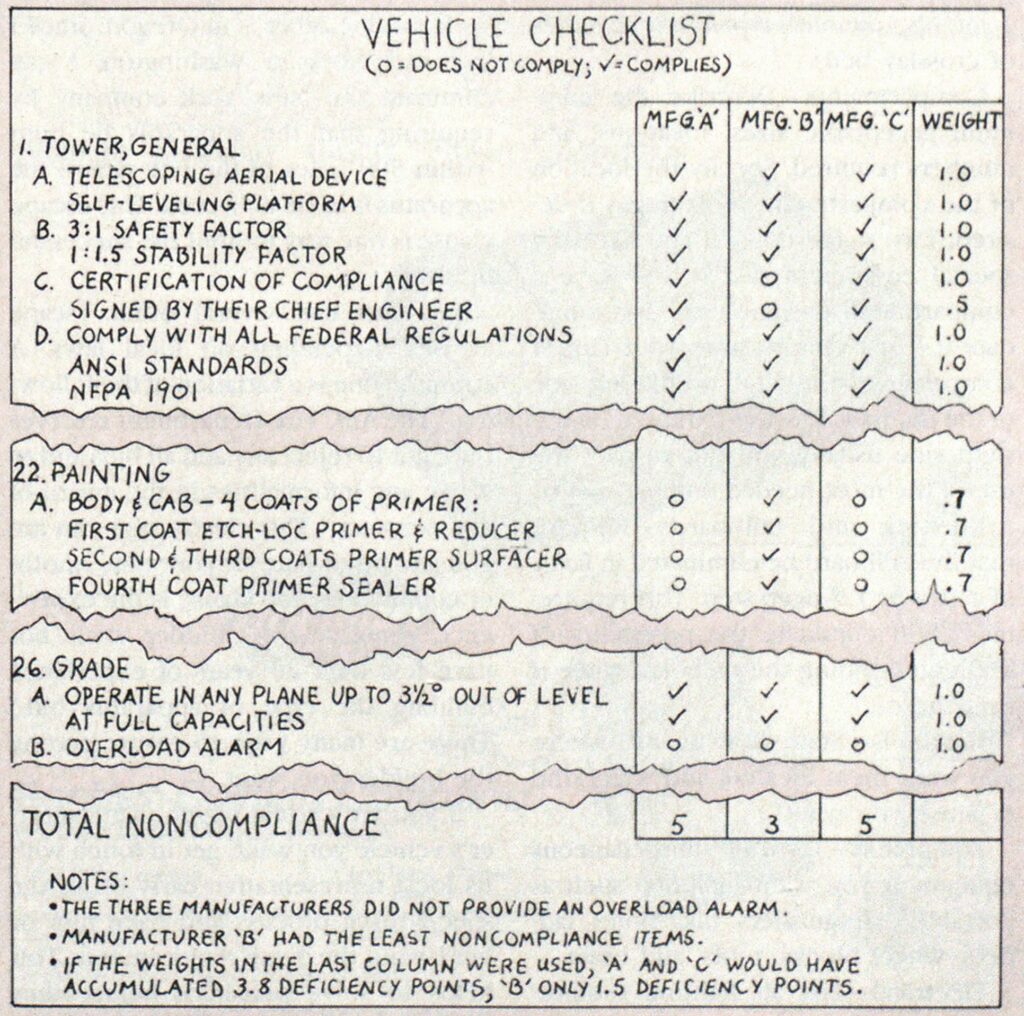
AFTER THE BIDS COME IN-A SIMPLE WAY TO SORT THROUGH YOUR OPTIONS
YOU’VE WRITTEN specifications for your apparatus and accepted bids from manufacturers. Now it’s decision time, and—assuming you aren’t already leaning toward one manufacturer—that means working hard to choose the package that best fits your department’s needs.
The follow ing may help you to evaluate the sometimes confusing array of packages, prices, and options submitted by bidders. Once again, it means more work, but that’s why you love the job anyway, right?
The process is time-consuming yet simple, lake a sheet of paper and list your specifications, item by item, on the left-hand side. Then draw as many vertical columns as you have bidders. In short, make a big checklist. The more elaborate or complex your bid is, the more items you will have listed along the left-hand column.
No matter how you construct your checklist, the following steps can be as simple or as involved as you care to make them. The simplest scheme is to check off the appropriate box as to whether or not the manufacturer can comply with your spec. A slightly more detailed procedure may use different colors—red if the manufacturer doesn’t comply, blue if it does, and green if it exceeds what you asked for. Thus the bidder with the most positive marks in the column, or the most blue and green, obviously is the one that promises to most fully satisfy your needs.
Even more involved, but decidedly more significant, is a system that assigns weight to the individual specification items based on their value to your department. For example, padded sun visors are nice. They are attractive and probably even add an element of safety, but are they as important as an adequately sized alternator for all the blinking, shining, rotating, winking, oscillating, throbbing, exploding electrical marvels that you asked for? Probably not!
This is not meant to insult your intelligence. Anyone who has dealt w ith committees—especially an apparatus selection committee—knows that oftentimes the importance attached to certain items varies from individual to individual. Realistically, there are certain apparatus components that are essential to the vehicle doing the job that you want it to. These critical elements are particular to the department. There are no worldwide criteria. What is important for your fireground operation may not be important in the next town. You know the relative merits of what you have specified. Giving them a value will lend rationality to your evaluation.
It might be helpful to select the critical elements and assign them a multiplier of 1.0. The less important items would receive a portion of the whole point rating. For example, an adequately lighted pump panel may be assigned a 0.7 multiplier, and a padded sun visor may be given a 0.1 multiplier. The actual number value is not as important as a consistent relative rating that is rational and justifiable.
It is strongly recommended that the relative values you assign be awarded to the items before the bids come in. It may further enhance the propriety of the proceedings if the relative values are unknown to the manufacturer and held by one of the other significant contributors in the process (town manager, council chairman, et cetera).

The culmination of the process, not surprisingly, is adding up the points. The bidder with the highest numerical score is the one promising to supply the vehicle that most nearly conforms with the essential items you have requested.
The bid evaluation process is merely the framework of a tool you can use to bring order to the selection process. It can be worked around, altered, and I changed to serve you best. At the least, some form of it can provide a rational approach to cutting through a lot of manufacturers’ claims. It can help lend legitimacy to a process that involves spending a lot of other people’s money and, most important, help you to provide your community with the best possible level of protection.

